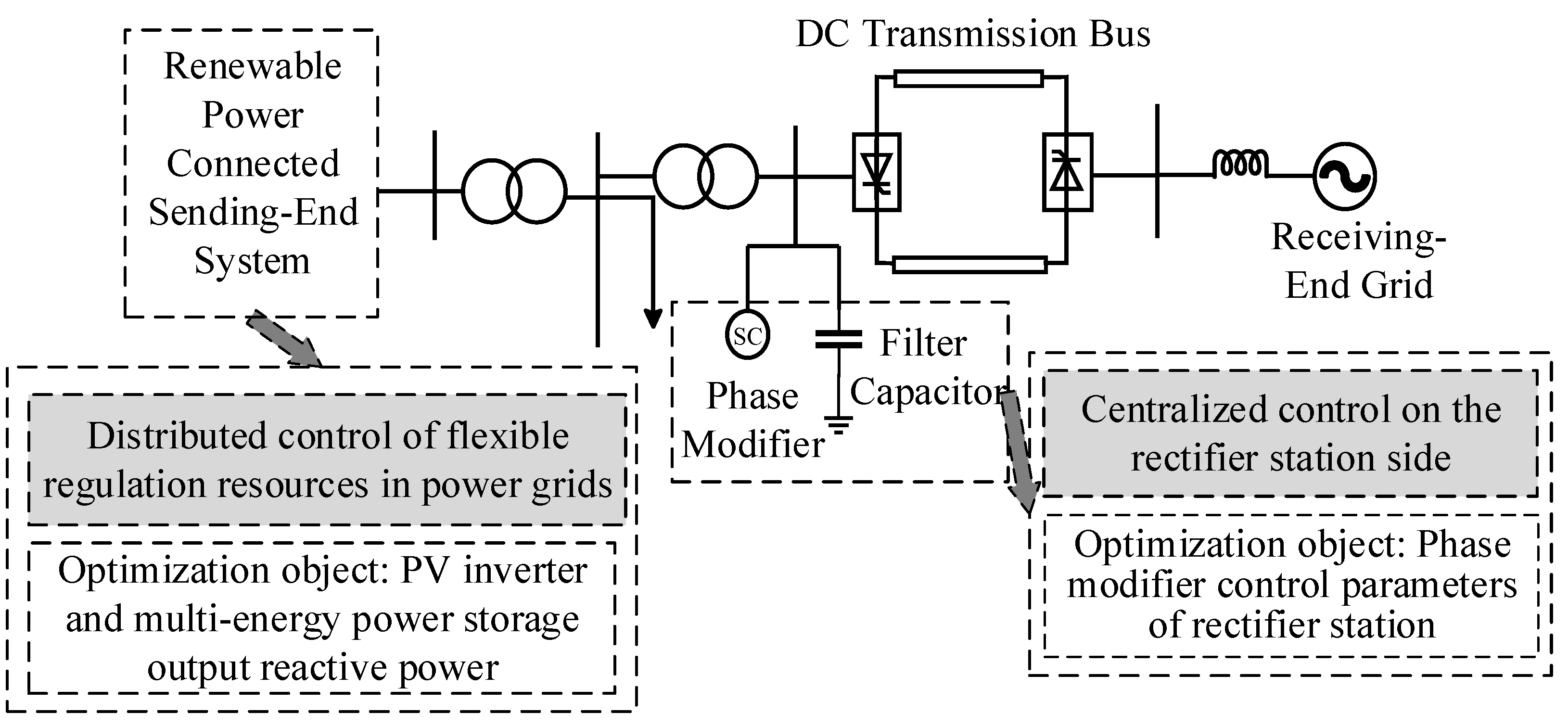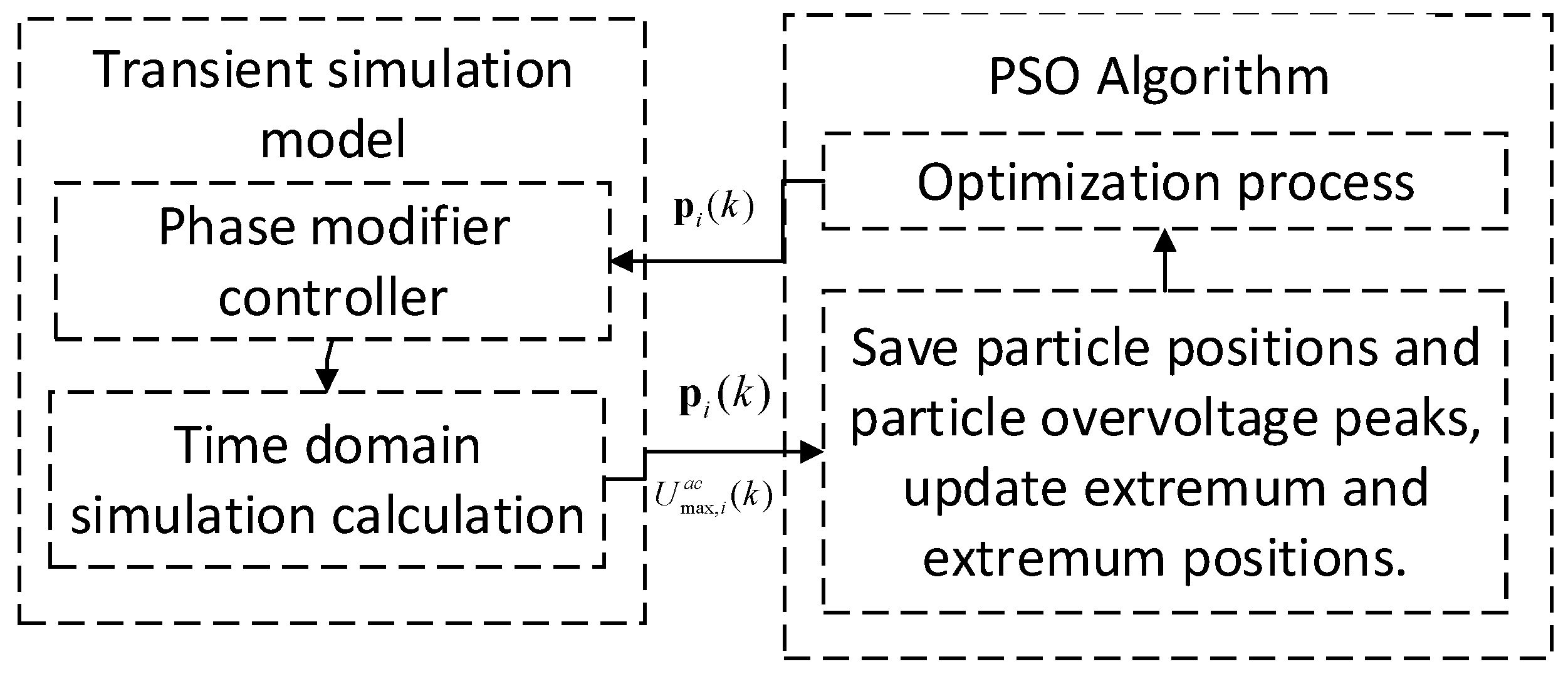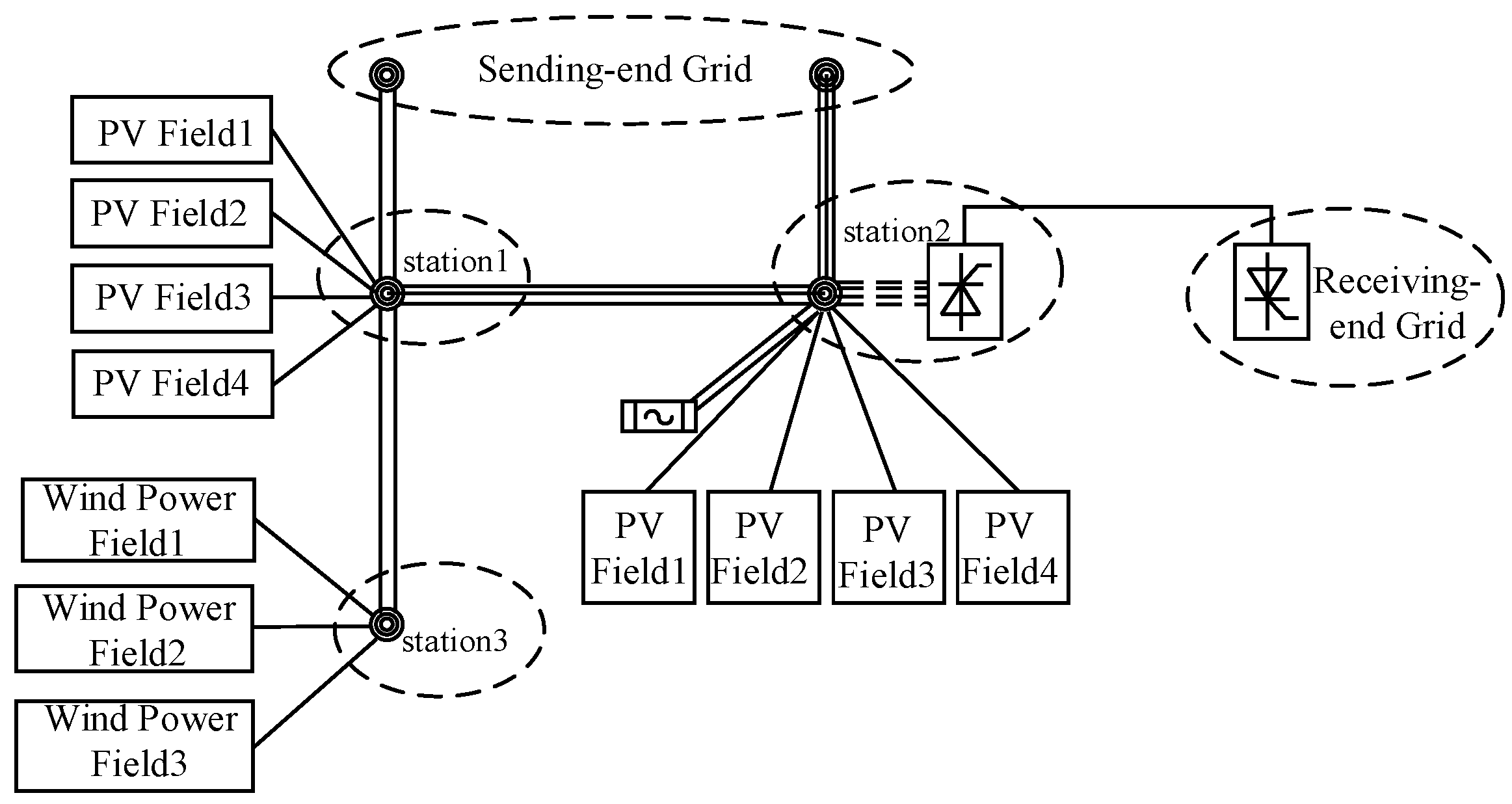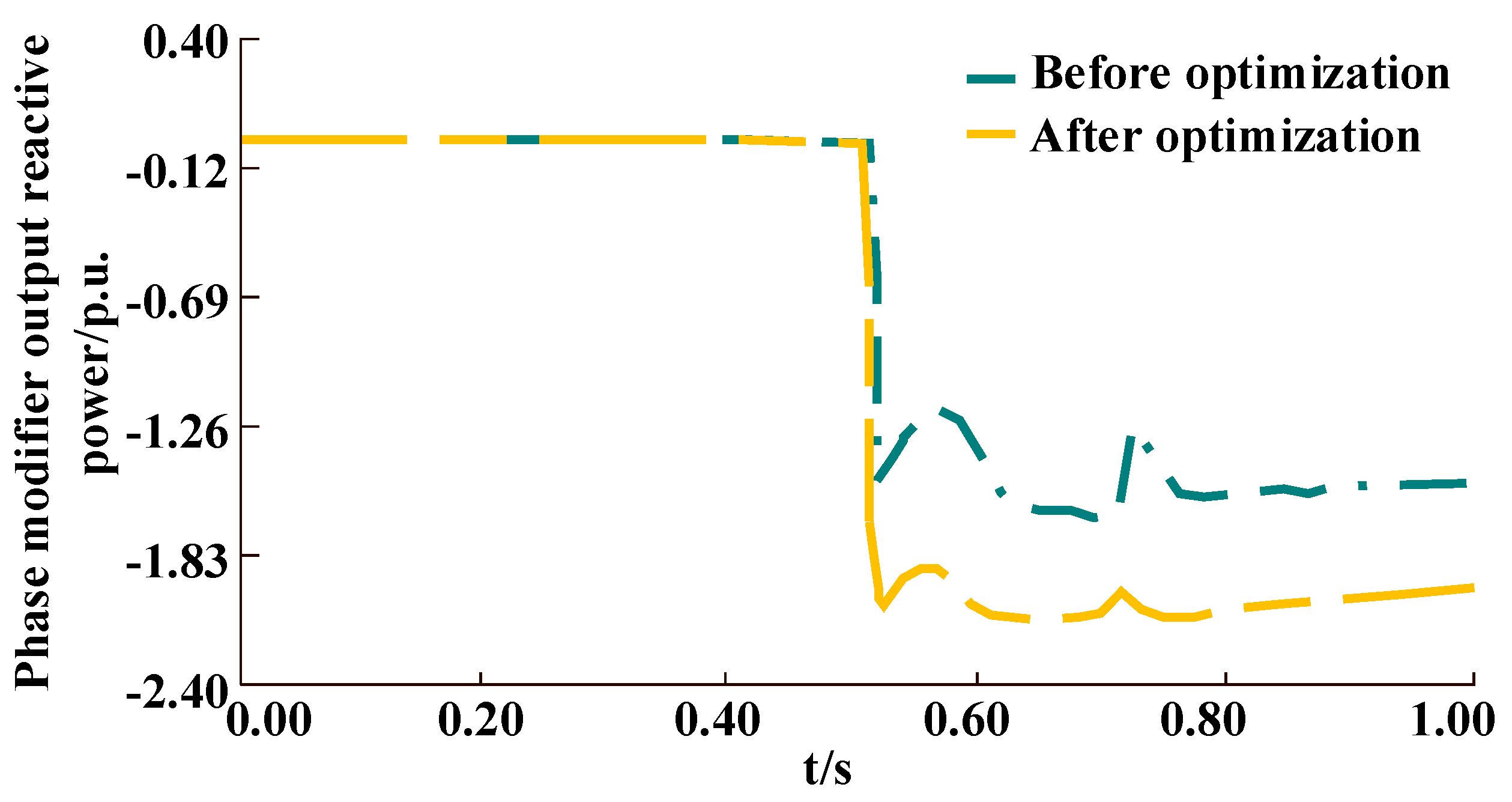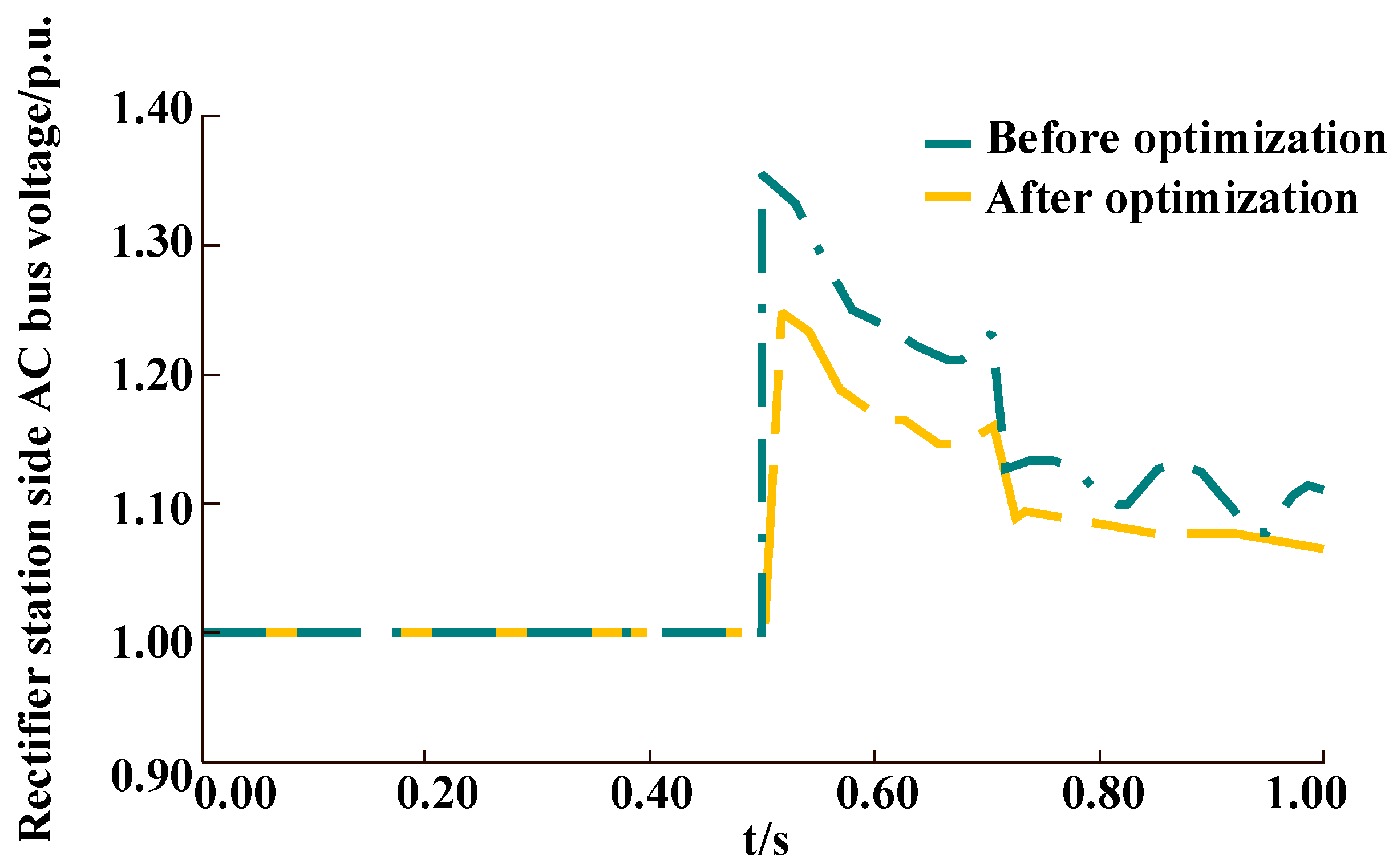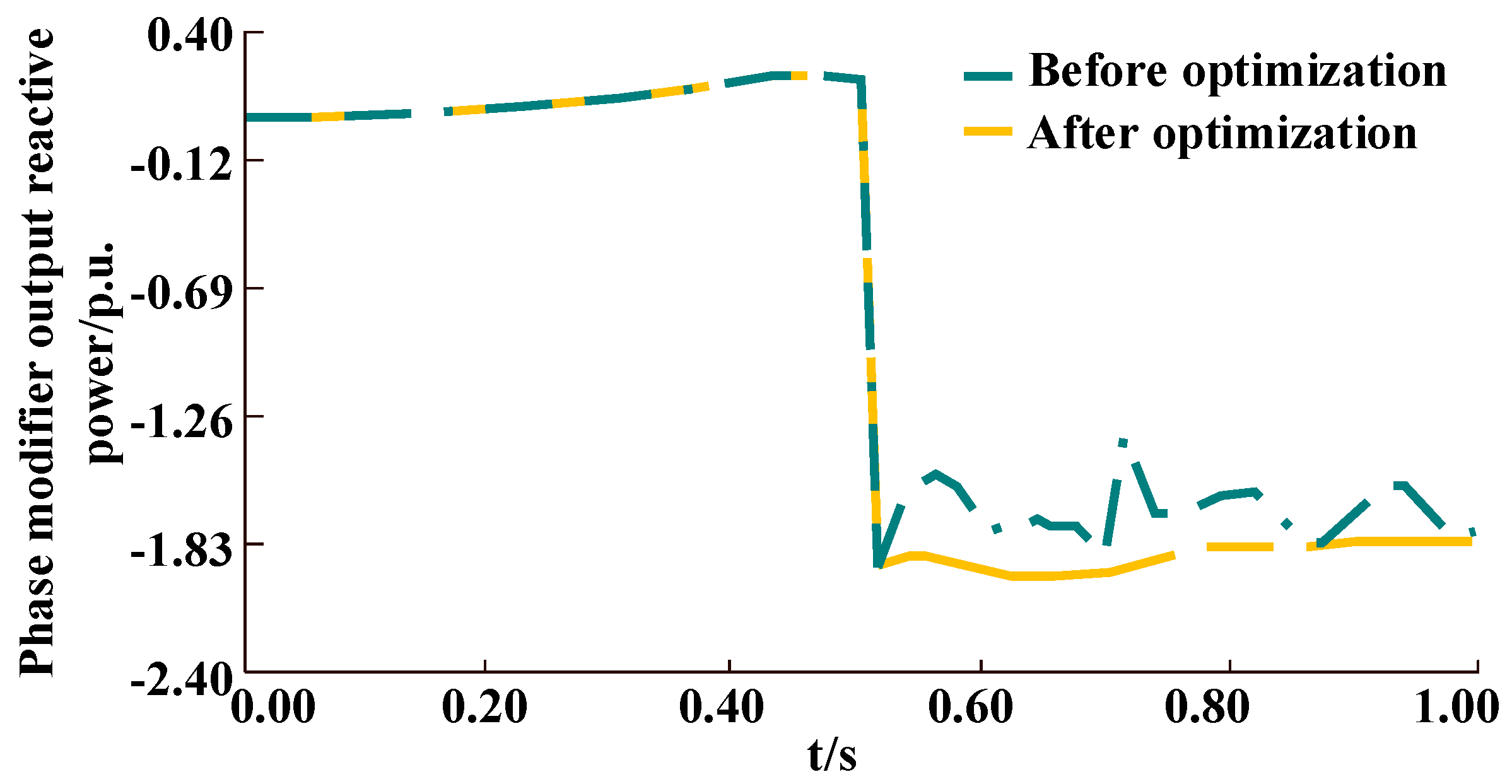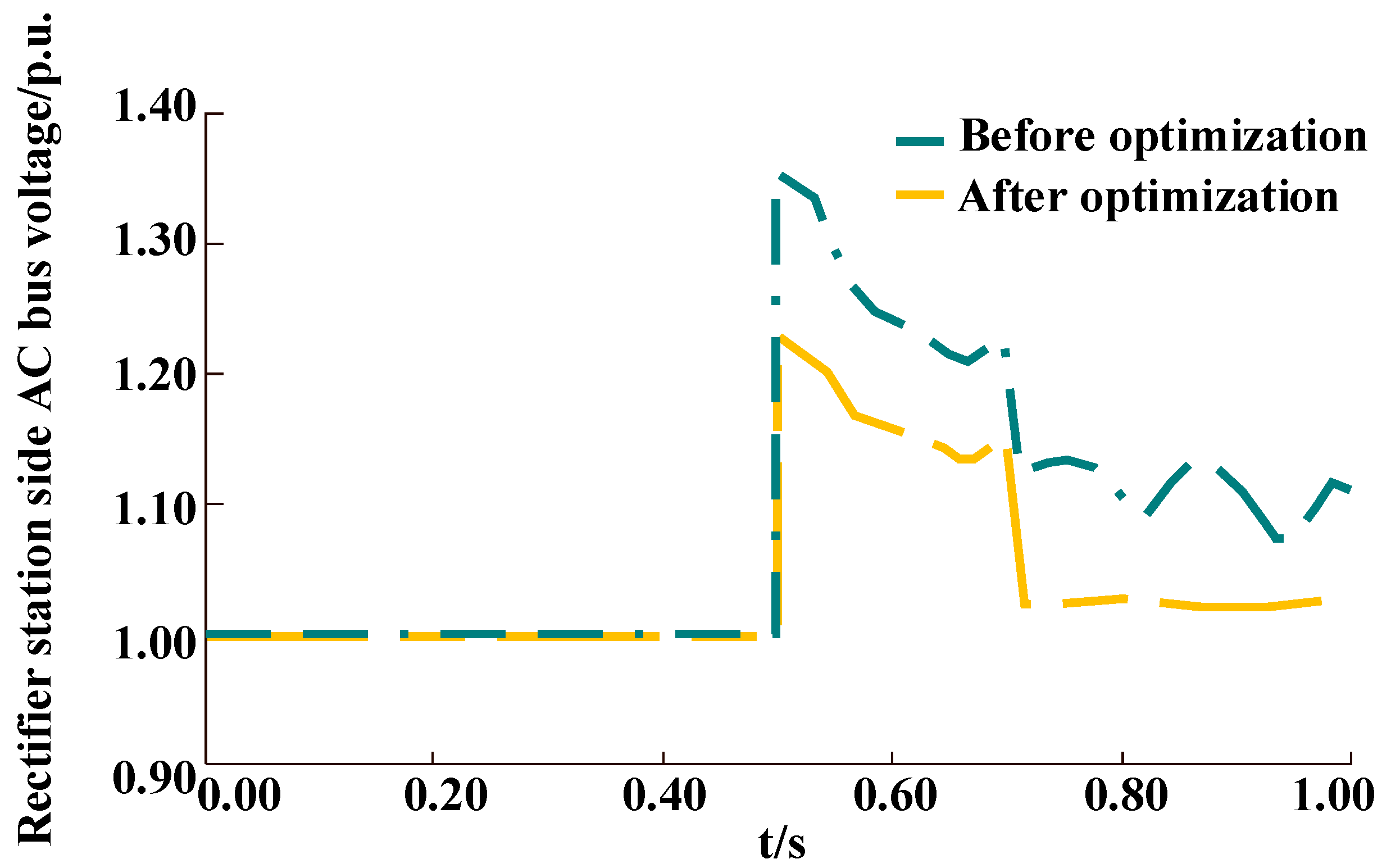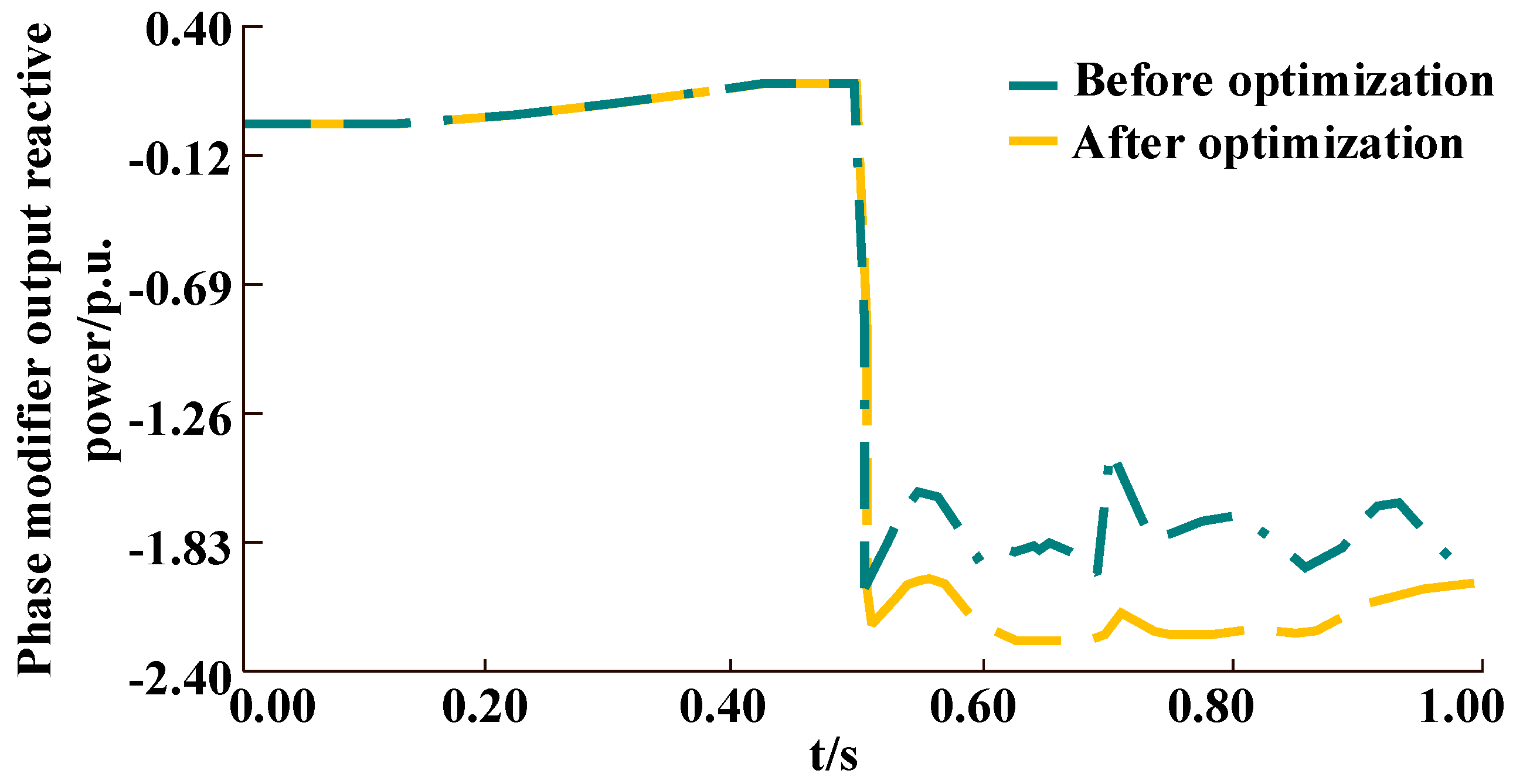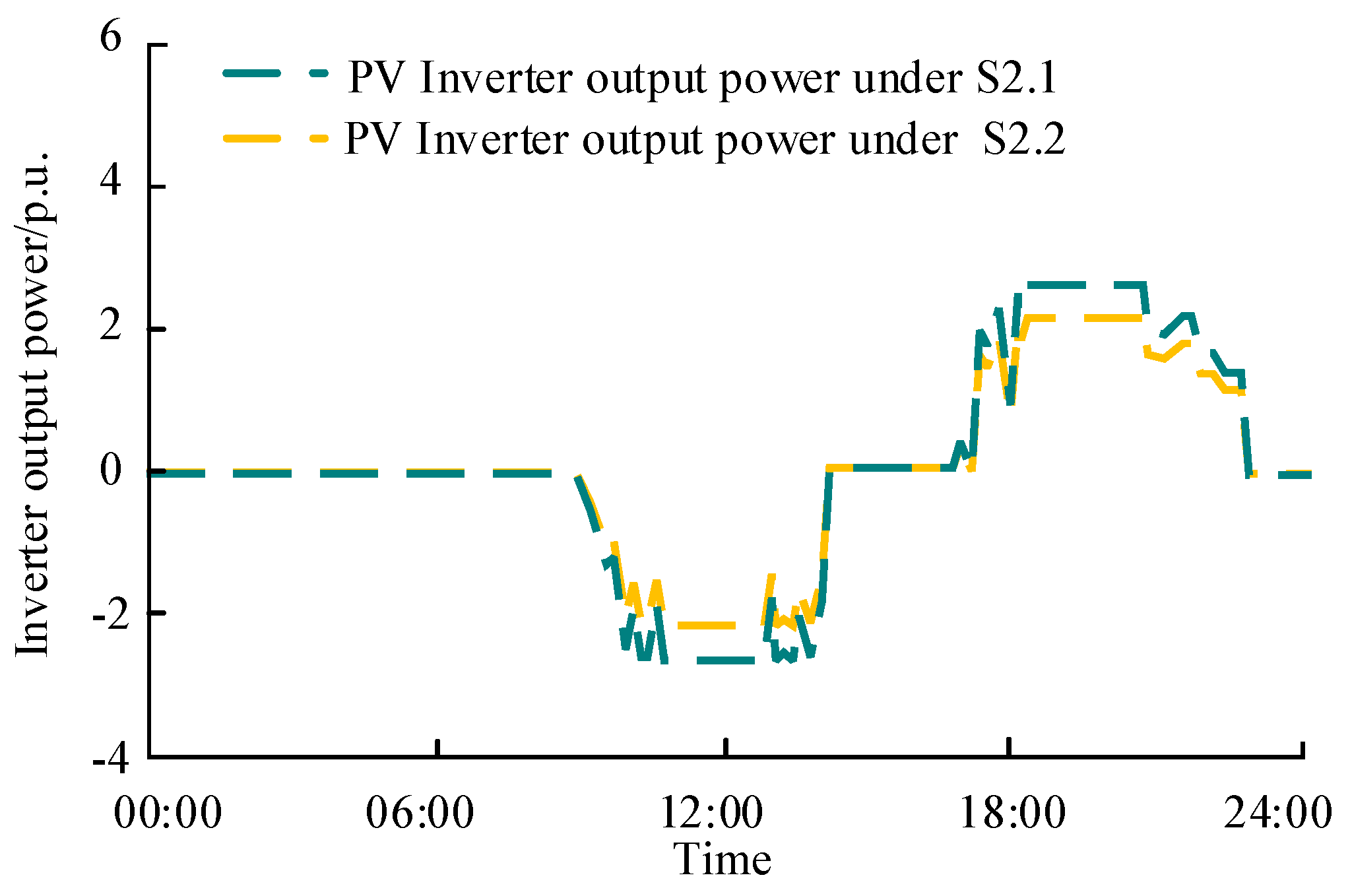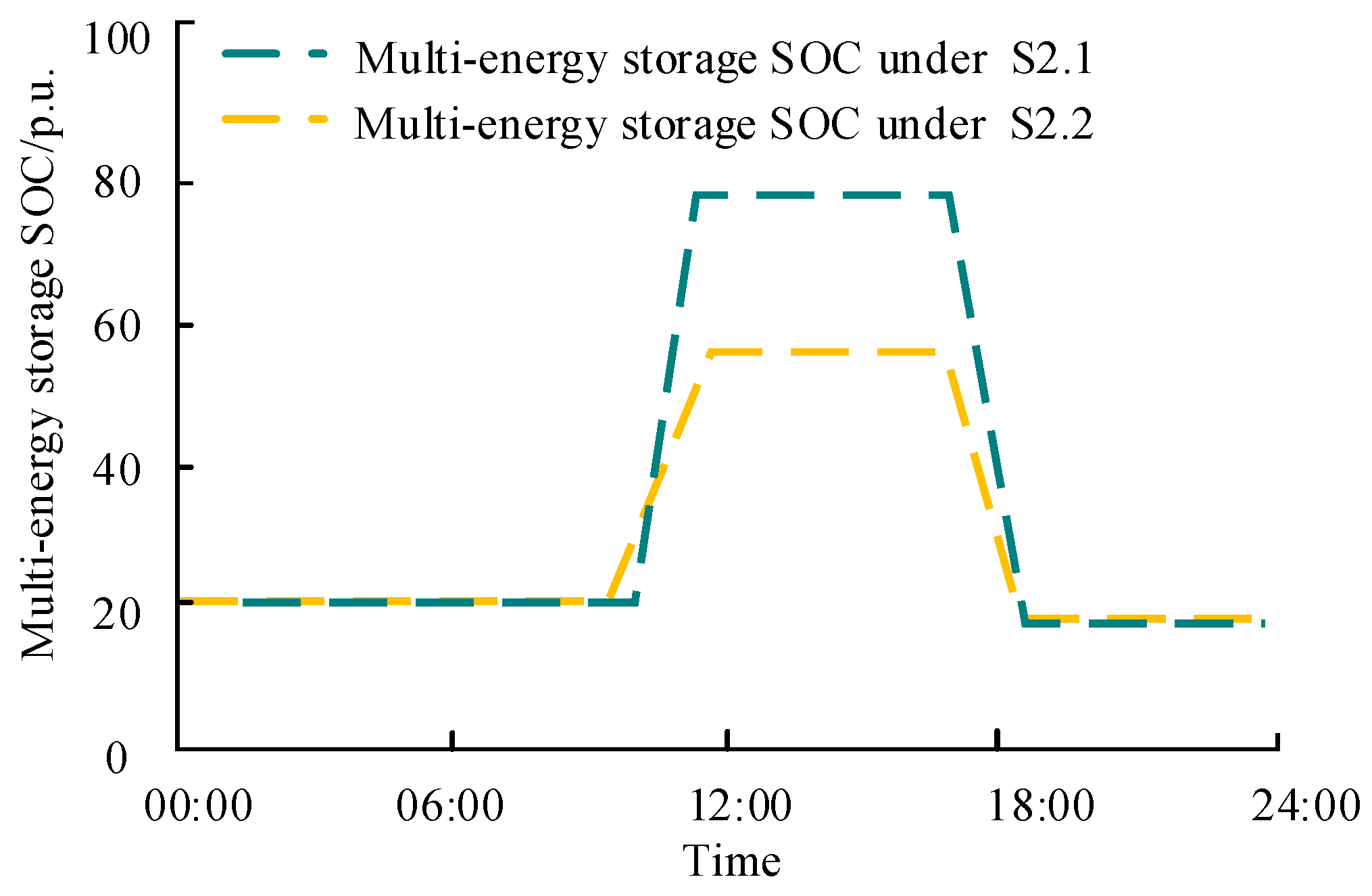1. Introduction
Currently, low-carbon energy systems with large-scale renewable energy integration have shown significant economic and social benefits in pollution control, resource conservation, and environmental protection worldwide. However, the reverse distribution of renewable energy and load centers makes high-voltage direct current transmission an important way to consume renewable energy. Therefore, it is necessary to study the related issues faced by large-scale renewable energy access DC transmission systems.
When a large number of renewable energy sources are connected to the power grid of the DC transmission system, there are many risks in the actual operation of the power grid. On one hand, there is a strong coupling relationship between the DC and incoming AC systems, reducing the operational safety zone of the power grid. On the other hand, large-scale renewable energy integration has led to a decrease in the inertia of the DC near area power grid and an increase in the risk of cascading faults. This also increases the probability of black out in the grid where a high proportion of renewable energy is delivered. So, it is urgent to coordinate and optimize the power supply of the low-carbon energy system transmission end grid, and the establishment of a regulation system urgently needs improvement [
1,
2,
3].
At present, the main measures taken to address the issue of the integration of renewable energy sources into the distribution network affecting voltage quality are still the traditional voltage regulation methods of the distribution network, including the use of on load voltage regulating transformers and the installation of reactive power compensation devices at specific points in the distribution network [
4]. These schemes have not yet taken into account the regulating capacity of distributed power sources and energy storage devices in the system, and generally have problems such as limited regulating capacity, high operating and maintenance costs, and poor economic efficiency. Therefore, they are not suitable for power grids with a large number of distributed power sources [
5].
At present, research on the suppression of system overvoltage mainly falls into two categories: equipment configuration optimization and control strategy optimization. In terms of voltage regulation equipment configuration research, reference [
6] pre plans the reactive power absorption demand by configuring converter station condensers and filter capacitors to achieve the purpose of suppressing transient overvoltage.
Reference [
7] proposes a method for implementing active power control in low-voltage power grids based on intelligent transformers. Reference [
8] proposes an overvoltage suppression method for energy storage devices based on short-term response to shorten the overvoltage duration. The response duration of energy storage overvoltage suppression is controlled within a few milliseconds. Reference [
9] proposes an adaptive droop control method for energy storage devices to stabilize the voltage of microgrid DC bus, with the energy storage SOC as the object of control. Reference [
10] proposes a strategy for active and reactive power injection based on amplitude phase-locked loops. APLL-based spontaneous active and reactive power support can alleviate transient overvoltage and improve transient performance in the transmitting and receiving regions.
In terms of optimizing overvoltage suppression strategies, reference [
11] proposes a reactive power controller based on sequential coordination method for voltage regulation in distribution systems. Reference [
12] proposes a multi voltage level DC power grid partition voltage regulation method based on the power grid partition method, which significantly reduces the number of DC circuit breakers in the power grid. Reference [
13] proposes a method to analyze the vulnerability of user equipment due to transient overvoltage using the transient voltage accumulation curve at the user end, ensuring the safe operation of users in the event of overvoltage.
Reference [
14] proposes a constant reactive power control that increases the reactive power consumed by the rectifier, reduces the exchange of reactive power between AC and DC systems, and suppresses transient overvoltage. Reference [
15] improves the global maximum power method identification method and proposes a maximum power point tracking method for photovoltaic systems, which improves the stability of the system. Reference [
16] proposes a predictive coordinated voltage control method for high permeability photovoltaic (PV) unit distribution systems. Reference [
17] proposes an integrated adaptive scheduling framework that coordinates distributed photovoltaic and energy storage systems to enhance system voltage regulation capabilities. Reference [
18] proposes a new autonomous control framework called “Grid Mind”, which uses DRL algorithm for training, enabling agents to formulate AVC strategies and take effective and timely control actions. Reference [
19] proposes a deep learning intelligent system that combines power system STVSA data augmentation. Based on a small dataset, it achieves short-term voltage stability assessment of the power grid.
In summary, current research on the overvoltage of the power grid at the transmission end of low-carbon energy systems is mostly focused on individual equipment types [
20], lacking research on collaborative operation control with the goal of fully utilizing the regulating potential of multiple equipment in the system, and unable to fully utilize the voltage regulating potential of low-carbon energy systems with large-scale renewable energy integration.
Therefore, from a global perspective, this article combines the system’s flexible resource optimization control strategy with transient overvoltage and reactive power compensation measures to jointly suppress overvoltage. This can fully utilize the automatic control and power tracking functions of photovoltaic inverters and multi energy storage devices in the system, leverage their advantages of sensitive response and fast action speed, and also reduce the additional investment cost of hardware equipment. To ensure the safe operation of the power grid for large-scale renewable energy integration, this paper proposes a two-stage overvoltage control strategy. Firstly, we analyze the overvoltage principle of the power grid at the transmitting end of high proportion renewable energy access, and clarify the transient overvoltage control objectives. To fully utilize the voltage regulation potential of the rectifier station condenser and the reactive power control potential of low-carbon energy systems, a two-stage overvoltage control model is established. Then, the control model is solved by combining the joint tuning method and consistency algorithm, and the voltage is adjusted by optimizing the parameters of the rectifier station condenser and adjusting the flexibility of the power grid to allocate reactive power back. Finally, the simulation results demonstrate the effectiveness of the control method proposed in this paper.
2. Two Stage Control of Grid Voltage at the Sending End of Low-Carbon Energy System
This article proposes a two-stage transient overvoltage control strategy for the sending-end power system of a low-carbon energy system with a high proportion of renewable energy integration. The coordinated control architecture is shown in
Figure 1.
The fundamental way to suppress overvoltage in the power grid at the sending end is to use voltage control equipment to absorb surplus reactive power in the power grid at the sending end. Therefore, when an overvoltage situation occurs, the two-stage control strategy proposed in this article optimizes the parameters of the rectifier station’s condenser and flexibly adjusts the reactive power backoff allocation of resources through centralized control on the rectifier station side and flexible resource distributed control on the power grid, thereby completing the suppression of overvoltage.
- (1)
Centralized control on the rectifier station side. Due to the characteristics of the modifier itself, its internal reactive power response components can be divided into spontaneous reactive power components and excitation control reactive power components. The spontaneous reactive power component can be controlled without delay response, but the support of the excitation control component is required in the follow-up. There is a 20 ms delay when the excitation control reactive component starts. After the excitation control reactive power component is activated, the phase modifier enters the deep phase advance operation state. At this time, the reactive power adjustment capability of the phase modifier is fully activated.
- (2)
Flexible resource distribution control for power grid regulation. There are various types of flexible resource adjustment equipment in the low-carbon energy system’s sending end grid [
21,
22]. This article mainly utilizes the advantages of fast response speed of photovoltaic inverters and various types of energy storage devices to coordinate photovoltaic inverters and multi-source energy storage to participate in the overvoltage control of the sending end system in the low-carbon energy system’s sending end grid. On the basis of considering the control capacity of the phase modifier, the reactive power backoff burden is redistributed to further suppress the overvoltage of the power grid at the sending end.
2.1. Centralized Control Model on the Rectifier Station Side
2.1.1. Phase Modifier Control Model
On the rectifier station side, the control parameters of the modifiers are optimized, and then the voltage regulation and control of the excitation regulator of the modifier is performed. The transfer function of the excitation control system of the modifier can be expressed as:
where
is the phase modifier power amplifier gain;
is the phase modifier series correction link gain;
is the phase modifier integral correction selection factor;
is the phase modifier control component;
are the time constant of serial correction link, measurement link, and power amplification link, respectively. The time constant of each link in the transfer function determines the delay time of the excitation response component.
The reactive power variation of the modifier
can be considered as the sum of the spontaneous reactive power component
and the excitation control reactive power component
. When the voltage of the AC bus of the sending end grid changes, the spontaneous reactive power component of the modifier automatically responds. Its reactive power instantaneous value calculation formula can be expressed as:
where
is the direct-axis subtransient reactance of the phase modifier;
is the difference between real-time voltage and steady-state voltage of AC bus of rectifier station;
is the steady-state voltage of AC bus of rectifier station;
is the phase modifier short-circuit reactance;
is the phase modifier initial value of direct axis current.
After the overvoltage occurs, after a delay of 20 ms, the excitation control system of the camera starts to adjust, and the excitation reactive power control component can be expressed as:
where
is the phase modifier excitation reactive power control component;
is the phase modifier excitation control system time parameter variable.
2.1.2. Phase Modifier Parameter Optimization Method
- (1)
Phase modifier control objective function
In the control process of the phase modifier, the objective function is to take the lowest peak value of the AC bus voltage of the rectifier station as the objective function, and the controllable parameters in the phase modifier are adjusted in series with the correction link gain and the power amplification link gain as the adjustment object.
Since the scale of DC transmission power can directly affect the AC bus voltage of the rectifier station, it is necessary to consider the influence of different scales of DC transmission, and optimize the controllable parameters of the phase modifier. The objective function can be expressed as:
where
is DC transmission power;
is AC bus transient overvoltage peak, it is taken as the particle fitness function
in the solution process.
- (2)
Restrictions
The upper and lower limits of the phase modifier parameters are constrained to be:
where
and
are the upper and lower limits of the gain of the phase modifier series correction link;
and
are the upper and lower limits of the power amplifier gain of the phase modifier.
When transient overvoltage occurs on the AC bus, the modifier should be in the under-excited state. The total amount of reactive power absorbed by it should be less than the maximum under-excitation capacity, so the capacity constraint of the phase modifier can be expressed as:
where
is the reactive power output by the phase modifier in steady state;
is the difference between the output reactive power of the modifier before and after the transient overvoltage occurs;
is the rated capacity of the phase modifier;
is the multiple of the capacity compared to the rated state when the phase modifier works in the overexcitation state.
2.1.3. Phase Modifier Parameter Optimization Solving Method
This article uses the PSO algorithm to optimize the parameters of the phase modifiers. Principle of the PSO algorithm is to abstract the elements in the optimization object into particles without mass and volume, and then form a population of these particles. In the population, the particles are screened by judging the fitness of the particles to the optimization target, and finally the optimal particle in the space is obtained, which is recorded as the optimal solution [
23].
When the particles in the population are screened for the (
k + 1)th time, the updated velocity and position of each particle can be expressed as:
where
is the speed of particle
update after the (
k + 1)th iteration;
,
are the original position and velocity of particle
;
is the inertia weights during iterative screening;
is the original position of the individual optimal particle before this iteration;
,
are learning factor at the (
k + 1)th iteration;
,
are random constant;
are the original position of the global optimal particle before this iteration;
is the updated position of particle
after the (
k + 1)th iteration.
The improved PSO algorithm is used to optimize and update the control parameters of the phase modifier. The inertia weight calculation expression is as follows:
where
is the inertia weight of particle
at the kth iteration;
,
are the maximum and minimum values that weights can take;
is the fitness function of particle
at the kth iteration;
is the lower limit of the fitness value of the particles;
is the average fitness of the particles. When using the improved inertia weight function to iterate the particles, when the fitness value of particle
is not less than the average value, select a small inertia weight to keep the particle near the global optimal point. Otherwise, choose the upper limit of the weight value to make the particle
close to the global optimal point.
At present, most research on the control of rectifier station phase modifiers only focuses on optimizing control parameters, without considering the combination of the accuracy of time-domain simulation models and the efficiency of intelligent optimization algorithms. This cannot accurately reflect the dynamic characteristics of the control system while ensuring the efficiency of optimizing control parameters. Therefore, this article adopts the method of joint invocation to optimize and solve the parameters of the phase modifier [
24].
The joint invocation method can combine the advantages of time-domain simulation and intelligent optimization algorithms. It updates the control parameters by calling the intelligent optimization algorithm (PSO algorithm in this article), and sends the updated control parameter values to the corresponding controller for time-domain simulation calculation. Therefore, it is possible to achieve data transfer and information exchange between each other, and the application principle is shown in
Figure 2.
The process of optimizing and solving phase modifier parameters based on joint invocation is divided into the following steps:
- (1)
Set the voltage data, simulation time for each particle, and control parameters to be optimized in the transient simulation model. Initialize particle swarm, set parameters for improved PSO algorithm, preset iteration accuracy, and upper and lower limits of control parameters to be optimized.
- (2)
Run a simulation program to sequentially insert the initial positions of particles into the electromagnetic transient model in time sequence for simulation. During operation, is calculated, and the individual optimal particle position , individual optimal extreme value , and the particle position corresponding to the particle with the smallest fitness function value of all particles are saved.
- (3)
Invoke improved PSO algorithm to update particle position, velocity, and inertia weights. Return the updated particle positions to the electromagnetic transient model for simulation.
- (4)
Determine whether the iteration accuracy meets the requirements. If it meets the requirements, the simulation ends and output ; If not, proceed to step (3).
2.2. Distributed Control Model for Power Grid Flexibility Regulation Resources
At present, the droop control method is usually used to control the inverter output in the sending end grid inverter control. However, droop control will inevitably lead to DC bus voltage drop in the control process, and line impedance mismatch will affect the accuracy of current distribution.
For this reason, consensus algorithm is used to redistribute the reactive power back-off burden generated by PV inverters after AC bus transient overvoltage occurs, overcoming the defects of droop control. The principle of redistribution is to select the reactive power utilization rate of photovoltaic inverters as a consistency variable, and adjust the output reactive power of each photovoltaic inverter through information exchange between photovoltaic inverters [
25].
The essence of the consensus algorithm is to update the state variables of local nodes through information interaction between local nodes and adjacent nodes, so that the state variables of nodes converge to stable common values. The controllable devices in the sending power grid interact with each other through the communication network to form a distributed communication network topology.
Communication topology can be described by directed graph:
where
represents the set of controllable devices, this paper represents photovoltaic inverters and multi-source energy storage devices.
represents the set of communication paths.
Let the state variable of node
m be
, where
b is the number of iterations.
indicates that node
m can receive information from node
n. In the control process, the state variables of each node are adjusted according to the state variables of its adjacent nodes. With the increase in the number of iterations, the state variables of the nodes tend to be consistent. When the state variables of all nodes reach consistency within the scope of convergence conditions, the system converges. The consensus algorithm can be described as:
where
is the state transition matrix coefficient;
is the collection of nodes receiving information.
where
is the number of all nodes that can send information to node
m.
2.2.1. PV Inverter Model
The mathematical model of photovoltaic inverter can be expressed as:
where
is the PV inverter state variables;
is the PV inverter control variables;
is the external disturbance,
,
are the coefficient matrix for PV inverter disturbance and control variables;
is the regulating PV inverter output;
,
are the coefficient matrix for regulating PV inverter output, which adapted to target in practical application.
When the AC bus transient overvoltage occurs, the reactive power backoff burden of each PV inverter is distributed according to the consensus algorithm. In order to make full use of the inverter capacity and distribute the voltage regulation tasks according to the inverter capacity, the reactive power utilization of the photovoltaic inverter is selected as the consistent variable.
is the ratio of reactive output power and reactive capacity of PV inverter at node
m, as:
where:
is the output power of photovoltaic inverter at node
m at time
t;
is the maximum reactive output power of photovoltaic inverter at node
m.
According to the consensus algorithm, the state variables of inverters in the network are updated according to the state variables of adjacent inverters. The reactive power utilization ratio
of the inverter at node
m at time
t is:
where
is the reactive power utilization result of the inverter at node
n adjacent to node
m after the last iteration.
According to the reactive power utilization results of photovoltaic inverters at each node obtained by iteration, it can be calculated that the reactive power required to be output by each photovoltaic inverter at time
t is:
2.2.2. Restrictions
where
is the voltage of node
m at time
t;
and
are the upper and lower limit of node voltage.
where
and
are the upper and lower limits of allowable output reactive power during inverter operation.
where
is the power factor angle of grid connected PV inverter at node
m.
2.2.3. Distributed Control Model for Multi-Source Energy Storage
When centralized control on the rectifier station side is difficult to completely suppress overvoltage, multi-source energy storage devices in low-carbon energy systems will participate in overvoltage control [
26]. This article focuses on the variation of SOC in multi-source storage
as a consistency variable, S not only considers the difference in installed capacity of multi-source energy storage to ensure consistent changes in SOC of multi-source energy storage, but also achieves simultaneous control of multi-source energy storage power and SOC, reducing control complexity.
When the voltage of the dominant node exceeds the upper limit, the SOC increases while the energy storage is being charged; When the voltage of the dominant node exceeds the lower limit, energy storage discharges while SOC decreases. The calculation of the energy storage SOC of the dominant node is shown as:
where
is the change in SOC of dominant node energy storage at time
t;
c is the adjusting parameters for convergence speed and accuracy of control methods.
According to the iterative principle of the consistency algorithm, update
of the energy storage device on node
m at time
t:
where
is the set of nodes connected to multi-source energy storage;
is the variation of multi-energy storage SOC at time
t on node
j.
Based on the change in SOC of multi-source energy storage, the active power of multi-source energy storage can be calculated as:
where
is the active power of energy storage on node
i at time
t;
is the energy storage capacity on node
i;
is the control time interval.
The SOC for multi-source energy storage at the next moment is:
2.2.4. Restrictions
Multi-energy storage SOC storage Multi-energy storage charging and discharging power constraints
where is the rated active power of energy storage device.
2.3. Two-Stage Overvoltage Control Process
In the centralized control model of the rectifier station side, this paper solves the parameter optimization process based on the joint invocation method. The solution process is shown in
Section 2.1.3. The iterative calculation update
is completed by PSO algorithm, and at the beginning of each simulation, it is imported into the controller corresponding to the transient simulation model for time domain simulation calculation. At the end of each simulation, the electromagnetic transient simulation model returns
and
, then updates the extremum and extremum position.
In the distributed control model of flexible resources in the power grid, this paper solves the reactive power backoff of each photovoltaic inverter and the charging and discharging power of multi-source energy storage devices based on consistency algorithm. Firstly, measure the reactive power output and node voltage of each node inverter in the second iteration at time t, and then calculate the reactive power output required for each inverter and multi-source energy storage device based on the distributed control model (Equations (11)–(23)). Control the reactive power output of each photovoltaic inverter and multi-source energy storage device, and the control is completed.
The overall solution process can be seen in
Figure 3.
4. Conclusions and Prospect
This paper proposes a two-stage voltage control strategy for the voltage regulation of the low-carbon energy system with a high proportion of renewable energy integration. A simulation system was constructed to verify the effectiveness of the proposed voltage regulation method, and the following conclusion is drawn:
- (1)
In the case of transient overvoltage, the two-stage voltage control method proposed in this article can suppress the AC bus voltage of the power grid without delay by optimizing the parameters of the phase modifier. Furthermore, it enhances the operational stability of the high proportion of renewable energy transmission to the power grid, prevents large-scale renewable energy disconnection caused by transient overvoltage, and reduces the probability of black out.
- (2)
The two-stage voltage control strategy proposed in this article can fully leverage the potential of flexible regulation equipment in the sending end power grid when the typical daily voltage exceeds the limit. It could shorten the duration of voltage exceeding the limit and reduce the peak value of voltage exceeding the limit. Therefore, it helps to extend the service life of power grid equipment, reduce the waste rate of renewable energy from the transmission end of the power grid, and effectively improve the economic efficiency of low-carbon power system operation.
However, from the simulation results in the article, it can be seen that after using the control strategy proposed in this article, there are still a few moments when the voltage exceeds the limit. This is because the reactive power capacity and energy storage depth of the photovoltaic inverter have reached the limit at these times, so the voltage exceeding the limit cannot be completely eliminated. Therefore, further research is needed on how to more thoroughly suppress overvoltage situations. At present, machine learning algorithms are widely used in the planning and management of energy systems around the world. However, in future research, it is also feasible to study the voltage suppression of sending-end power grids with high proportion of new energy access based on machine learning algorithms.
